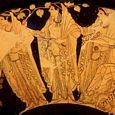
Yet, when I checked my dictionary / encyclopedia program, containing 50+ dictionaries and encyclopedias, not one of them had an entry other than Greek goddesses and Latin "hour" / "times" for this word. It is almost like I am already supposed to know what the word means. But over the course of 30+ minutes, I found nearly a dozen different publications with the word "Horae" in the title, and not a single webpage translated it. They represent the Horae, who are the ancient Greek goddesses also called the Graces. This is the first rotation of three large beads in black, dark blue and white. You would think if someone was referencing "Horae Biblicae," or selling a book online, they might actually bother to translate the name into English-at least somewhere, on some website. Prayer Bead Colors for the Order of the Horae. I'm utterly stunned that out of nearly a dozen books online with the title "horae," not one webpage bothered to translate the title (including "horae") into English. Whoever can answer what it exactly means in scholarly works like these below, you will deserve a hefty reward.

She is associated with mountains, blizzards, glacial floes. But that is clearly not the context in which "horae" is used in titles like those above. Khadi the Frigid One, the Giant goddess of winter and patron of bowhunting, skiing, and endurance. The second was called Karpo, who personified the ripening of summer. One was Thallo, also called Thallate, who was the goddess of spring, buds and blossoms. Among the most important of these beings were the Horae. Dik (, Justice Iustitia for Romans) was the goddess of moral justice: she ruled over human justice, as her mother Themis ruled over divine justice. According to the Ancient Greeks from Athens, however, there were three Horae in Greek mythology. In Greek mythology, items of nature were usually personified in the form of a god or goddess. These three goddesses were responsible for making sure the three seasons came in the correct order and lasted the appropriate amount of time.

They were Thallo, the goddess of spring, Auxo, the goddess of summer, and Carpo, the goddess of autumn. mw parser output div.hatnote padding left 1.6em margin bottom 0.5em. Opinions differ as to the number and names of the Horae. Instead, the Horae were usually shown in charge of the seasons of the agricultural year.

And aside from that, most dictionary entries refer "horae" to false Greek goddesses of seasons (hence "times"). search Greek mythology goddesses the seasons and time.mw parser output. The Horae are the Greek Goddesses known for the hours of the day and are also related to the word. Although they controlled the recurrence of the. Yes, I quickly found the Latin meaning of the word. see website for series discount exchange. Horae (hr), in Greek religion and mythology, goddesses of the seasons daughters of Zeus and Themis.


 0 kommentar(er)
0 kommentar(er)
